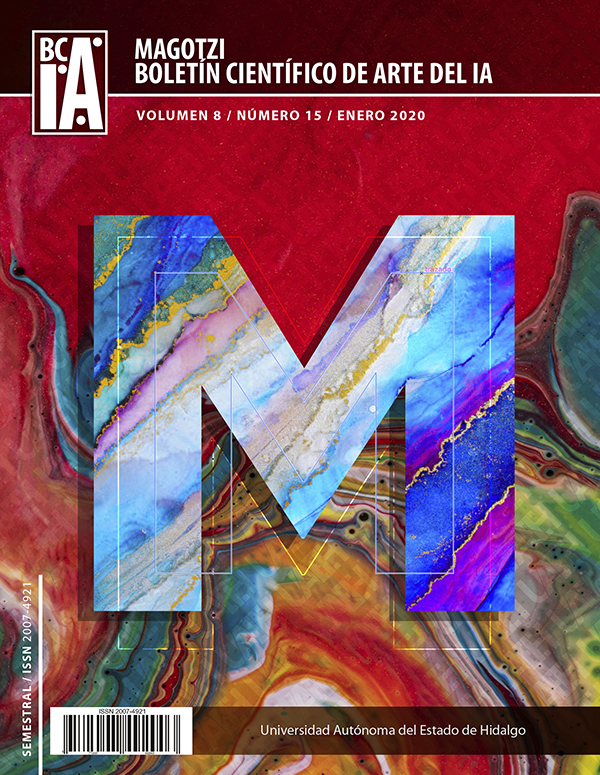Discourses and Antecedents of the Feminist Portraits in Contemporary Art
Abstract
Art has served as a tool to spread different philosophies and thoughts. At the beginning of the 21st century, feminism uses artistic portrait to make known gender inequality. The present essay contain two sections that explain how feminist thought and artistic portrait collaborate to criticize society. In the first section are mentioned the different approaches to art, the sum of the disciplines with which the works are supported for their conceptualization and the representation of the feminine paradigms. In the second, are mentioned examples of feminist discourses in the portraits for a denunciation to the contemporary world. In the last section, there is a reflection on how art with a critical content has the ability to direct viewers towards an understanding of equity and thereby carry out a cathartic act. On the other hand, the methodology is of a qualitative nature, that is to say, both the works and the theories were selected to sustain the work.
Downloads
References
Acha, J. (1993). Expresión y apreciación artísticas: artes plásticas. D.F., México: Editorial Trillas.
Berger, J. (2000). Modos de ver. Gustavo Gili
Blocker, J. (2007). Tierra. K. Cordero e I. Sáenz (coompiladoras). Crítica feminista en la teoría e historia del arte (pp. 377-400). D.F., México: CONACULTA.
Bourdieu, P. (1998). La dominación masculina. París, Francia: Editorial Anagrama.
Butler, J. (2007). El género en disputa: El feminismo y la subversión de la identidad. Ediciones Paidos Ibérica, New York.
Dröes, F. (2006). Art at the edge: The painter Marlene Dumas. Feminist Theology, 14(3), 389–397. DOI: 10.1177/0966735006063776.
Galarza Fernández, E., Cobo Bedía, R., y Esquembre Cerdá, M. (2016). Medios y violencia simbólica contra las mujeres. Revista Latina de Comunicación Social. DOI: 10.4185/RLCS-2016-1122.
García, A. (2005). Enseñanza y aprendizaje en la educación artística Teaching and Learning in Artistic Education, 80–97.
Giunta, A. (2018). Feminismo y arte latinoamericano: historias de artistas que emanciparon el cuerpo. Buenos Aires, Argentina: Siglo veintiuno editores.
Lara, M. (2007). La memoria es como una piedra pulida. K. Cordero e I. Sáenz (coompiladoras). Crítica feminista en la teoría e historia del arte (pp. 415-420). D.F., México: CONACULTA.
Mandoki, K. (2006). Prácticas estéticas e identidades sociales: Prosaica II. Tlanepantla, México: conaculta.
Mandoki, K. (2008). Estética cotidiana y juegos de la cultura: Prosaica l. D.F., México: Conaculta.
Martínez-Artero, R. (2004). El retrato: Del sujeto en el retrato. Montesinos.
Mayer, M. (2009). Un breve testimonio sobre los ires y venires del arte feminista en México durante la última década del siglo XX y la primera del XXI. Debate Feminista, 40, 191–206.
Meagher, M. (2003). Jenny Saville and a feminist aesthetics of disgust. Hypatia, 18(4), 23–41. DOI:10.1353/hyp.2003.0085.
Patrón, M. (2018). El libro-arte en México en el siglo XXI como dispositivo de resistencia social. M. Achig (Coord.). El arte de la edición y la tipografía (pp. 39-50). (1st ed.). Ciudad Juárez, México: Universidad Autónoma de Ciudad Juárez.
Pinotti, A. (2011). Estética de la pintura. Madrid, España: Machado Libros.
Pollock, G. (2007). La heroína y la creación de un canon feminista: Las representaciones de Artemisa Gentileschi de Susana a Judit. K. Cordero e I. Sáenz (coompiladoras). Crítica feminista en la teoría e historia del arte (pp. 161-196). D.F., México: CONACULTA.
Rodríguez, I. (2010). El retrato contemporáneo. Del realismo a la pérdida del rostro. Revista de Estética y Arte Contemporáneo, 2, 46–57.
Rosas, C. (2013). La reivindicación de la ciudad por el arte urbano: Ciudad Juárez, Chihuahua, México. Arte y Ciudad, 3, 59–70.
Sánchez, A. (1996). Cuestiones estéticas y artísticas contemporáneas. Fondo de Cultura Económica.
Villa, F. y Gatica, A. (2018). Libros para la memoria: Creación colectiva de libros-arte en pueblos originarios de México. M. Achig (Coord.). El arte de la edición y la tipografía (pp. 51-59) (1st ed.). Ciudad Juárez, México: Universidad Autónoma de Ciudad Juárez.
Vulliamy, E. (2014). Painted back to life: Brian Maguire’s portraits of the victims of Mexico’s “feminocidio” | The Guardian. Retrieved February 24, 2019, from https://www.theguardian.com/artanddesign/2014/may/04/brian-maguire-portraits-victims-mexico-feminocidio-ciudad-juarez.












